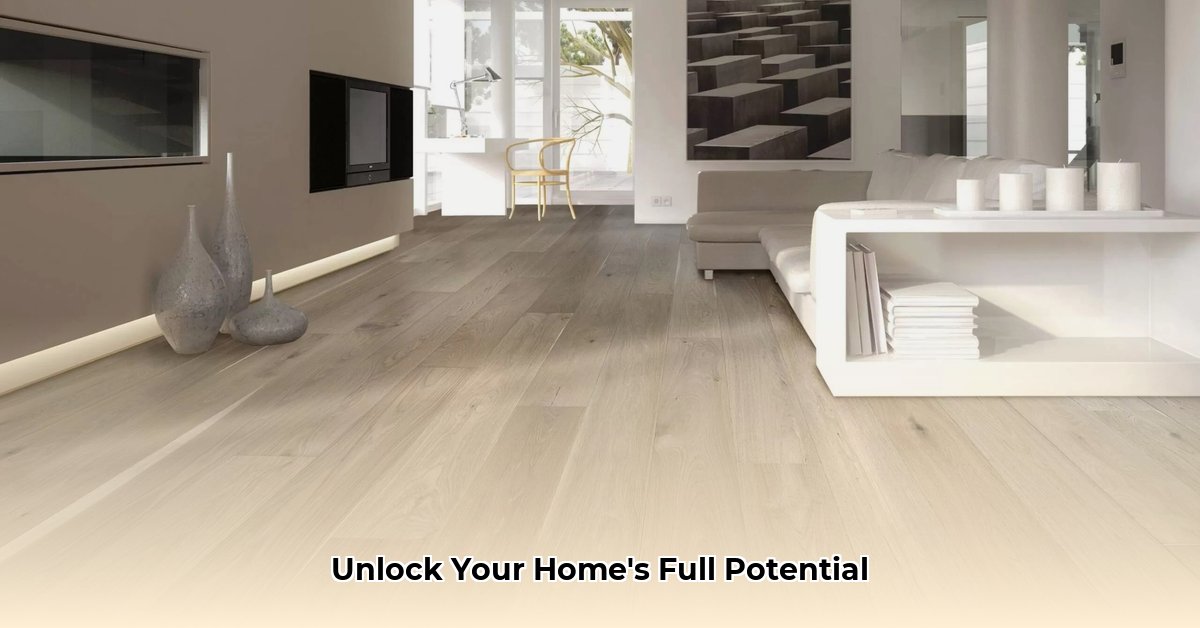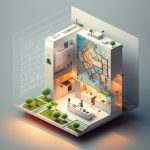Understanding floor plan zoning is key to designing a home that’s both functional and beautiful. This guide will walk you through the essentials, common pitfalls, and actionable steps to create the perfect living space. Whether you’re building or renovating, this guide has you covered. For more efficient layout ideas, check out this helpful resource on efficient floor plans.
Floor Plan Zoning: Designing Your Dream Home
Floor plan zoning is about arranging your home’s spaces for optimal flow, functionality, and harmonious living, much like thoughtfully arranging furniture. It shapes the entire feel of your house, making it more than just a collection of rooms. Consider it the blueprint for comfortable living.
Public and Private Zones: Comfort and Privacy
Separating public and private zones is crucial for a comfortable home. Public zones (living room, kitchen, dining area, family room) are for togetherness and should flow seamlessly, fostering connection and interaction. Private zones (bedrooms, bathrooms, home offices, studies) need seclusion for relaxation, work, and personal time. Strategic placement minimizes noise and maximizes peace. For example, avoid placing bedrooms directly adjacent to a noisy living room or a busy kitchen. Consider buffering private areas with transitional spaces like hallways or closets. This design strategy creates harmony and enhances the overall livability of the home.
Circulation: Optimizing Residential Traffic Flow
Poor circulation leads to bumping into walls and backtracking. Effective floor plan zoning prevents this. Aim for easy, intuitive movement throughout your house. Minimize long, narrow hallways, carefully place doors to avoid obstructing pathways, and ensure a logical path between areas. Consider the placement of furniture to avoid creating obstacles. A clear, unobstructed path from the entryway to the main living areas is essential. Good circulation creates a comfortable and inviting atmosphere, much like well-planned city streets ensure smooth traffic.
Space-Saving Strategies: Making the Most of Every Square Foot
Maximizing space is key, especially in smaller homes or urban dwellings. Clever zoning techniques make a big difference. Open floor plans create spaciousness, but define distinct zones using flooring changes, rugs, furniture arrangement, or subtle level changes. Multi-functional spaces, like a combined living and dining area or a guest room that doubles as a home office, free up extra room and increase the utility of your space. Also, consider vertical space with lofts, high ceilings, built-in shelving, and strategic storage solutions to maximize every inch. Utilizing wall-mounted fixtures and floating shelves can also minimize clutter and create a more open feel.
Style and Zoning: Customizing Home Spaces
The style of your house greatly influences floor plan zoning. A modern home with clean lines and open spaces has different zoning needs than a traditional farmhouse with distinct rooms and cozy nooks. Zoning choices must complement your home’s aesthetic for seamless integration. In a modern home, emphasize open-concept living and minimalist design. In a traditional home, focus on creating distinct, well-defined rooms with a sense of warmth and character. The goal is a cohesive whole, where style and layout work harmoniously to reflect your personal taste and lifestyle.
Technology and Zoning: Smart Homes, Smart Zoning
Smart technology impacts zoning by streamlining needs and enhancing functionality. A smart home system might eliminate the need for a dedicated media room by integrating entertainment features into the main living area. Consider incorporating a centralized control system for lighting, climate, and security to optimize energy efficiency and convenience. Integrate technology seamlessly into your home’s layout to embrace the future, creating a connected and efficient living environment. Consider future-proofing your home by including ample wiring and network infrastructure to accommodate emerging technologies.
Accessibility: Designing for Everyone
Accessibility is crucial for all ages and abilities. Universal design considers wide doorways (at least 36 inches), ramps or zero-step entrances, grab bars in bathrooms, and adaptable features that can be easily modified to meet changing needs. Plan this from the beginning to adapt for the future. Consider adjustable-height countertops in the kitchen and bathrooms to accommodate users of different heights. It’s about making your home welcoming and functional for everyone, regardless of their physical abilities.
Floor Plan Zoning Checklist: A Quick Review
Before finalizing your plans, review:
- Privacy: Are quiet zones separate from noisy areas?
- Flow: Is movement intuitive and easy?
- Space: Is every square foot used efficiently?
- Style: Does zoning blend with your home’s style?
- Technology: Is technology integrated thoughtfully?
- Accessibility: Is your home welcoming for everyone?
- Storage: Is there ample and well-placed storage throughout the home?
- Lighting: Is natural light maximized and supplemented with appropriate artificial lighting?
- Outdoor Connection: Does the design facilitate easy access to and enjoyment of outdoor spaces?
Potential Pitfalls & Solutions: Navigating Common Challenges
| Potential Problem | Solution |
|---|---|
| Insufficient Privacy | Use strategic room placement, consider soundproofing materials (insulation, thicker walls), and incorporate buffer zones like hallways or closets. |
| Poor Circulation | Optimize hallway and door placement to maximize flow. Consider widening hallways and creating clear pathways between rooms. |
| Wasted Space | Utilize multifunctional furniture (sofa beds, storage ottomans) and built-in storage solutions (shelving, cabinetry). |
| Style Mismatch | Ensure that the layout complements your home’s architectural style. Consult with an interior designer to achieve a cohesive aesthetic. |
| Technology Integration Issues | Plan carefully, consult with a technology expert, and ensure sufficient wiring and network infrastructure. |
| Inadequate Storage | Incorporate built-in storage solutions, utilize vertical space, and declutter regularly. |
| Poor Lighting | Maximize natural light with large windows and skylights. Supplement with appropriate artificial lighting, including task lighting, ambient lighting, and accent lighting. |
| Lack of Outdoor Connection | Create outdoor living spaces, such as patios or decks, and ensure easy access to them from the main living areas. Consider adding large windows or sliding doors to blur the lines between indoors and outdoors. |
Mastering floor plan zoning creates a home that truly works for you. Thoughtful planning creates a comfortable, functional, and enjoyable living space you’ll cherish for years.
Integrating Smart Home Technology into Efficient Residential Floor Plans
Integrating smart home technology requires careful planning and a holistic approach. In 2023, the global smart home market reached a value of \$103.8 billion and is projected to grow to \$176.2 billion by 2028 (Statista), indicating a significant and accelerating trend toward technological integration in residential design.
Key Takeaways:
- AI assists in rapid floor plan design, offering diverse options and optimizing space utilization.
- Integrating smart homes needs mindful space planning, ensuring seamless functionality and aesthetics.
- Adhering to zoning regulations is crucial for safety, compliance, and community harmony.
- Effective wiring and network infrastructure are essential for reliable smart home performance.
- User satisfaction and data protection stay critical for responsible and sustainable smart home adoption.
Planning for Seamless Smart Home Integration
Before beginning the design process, plan your smart home’s infrastructure meticulously. Think of your home’s network as a circulatory system needing to reach everywhere efficiently and reliably.
-
Data Infrastructure: Decide where the main network hub (router and modem) will be. Optimal placement minimizes signal loss and ensures consistent Wi-Fi coverage throughout the home. Pre-wiring for ethernet cables to key locations (entertainment centers, home offices, security hubs) will prove invaluable now and in the future, providing a more stable and faster connection for bandwidth-intensive applications. Consider incorporating a mesh Wi-Fi system to extend coverage to all areas of the home, including outdoor spaces.
-
Smart Device Placement: Ensure consistent Wi-Fi signals for smart devices. Strategically position smart speakers for clear audio and optimal voice control. Consider the placement of smart sensors (motion detectors, temperature sensors) to maximize their effectiveness.
-
Power Considerations: Ensure sufficient outlets, especially in areas with multiple devices. Pre-wiring for smart plugs or power over ethernet (PoE) can simplify future installations and reduce clutter. Consider incorporating a whole-house surge protector to protect your smart devices from power surges.
Zoning and Spatial Optimization for Smart Home Features
Integrating smart home technology requires careful zoning to optimize functionality and enhance the user experience. Separate “smart” zones improve functionality and security, allowing for customized control and automation in different areas of the home. Recognize that different areas have unique needs and don’t share importance equally across all spaces.
-
Entertainment Zone: Dedicate a space for home theater setups. Run ethernet cables to optimize streaming performance and minimize buffering. Consider smart lighting (dimmable lights, color-changing lights) to create the perfect ambiance for movie nights. Integrate smart blinds or curtains that can be automatically adjusted to block out sunlight.
-
Security Zone: Plan for strategic placement of security cameras (doorbell cameras, indoor/outdoor cameras), sensors (window/door sensors, motion detectors), and smart locks. Consider dedicated storage for recordings and a backup power supply for the security system. Implement geofencing technology to automatically arm or disarm the security system based on your location.
-
Kitchen Zone: Ensure sufficient electrical capacity and data connections for smart appliances (smart refrigerators, smart ovens, smart dishwashers). Consider incorporating a smart kitchen assistant (e.g., Amazon Echo Show, Google Nest Hub) for voice control and recipe guidance.
-
Bedroom Zone: Ensure for smart lighting, climate controls (smart thermostats), and security
- Modern Kitchen Backsplash Ideas To Inspire Your Refresh - December 19, 2025
- Modern Backsplash Ideas: A Guide to Todays Kitchen Trends - December 18, 2025
- Ceramic Kitchen Wall Tiles: Style and Protection for Your Walls - December 17, 2025









